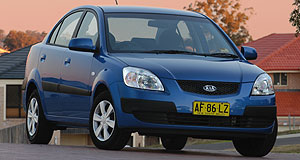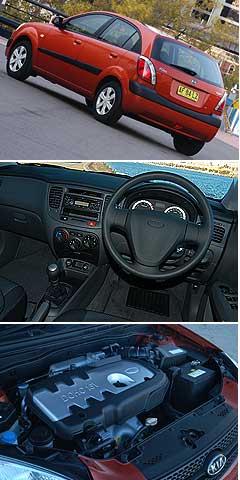First drive: Kia Rio II offers substance and value
BY NEIL MCDONALD | 30th Aug 2005

A lot is expected of Kia's biggest-selling model, which in 2004 was the third-most-popular vehicle in the light-car segment behind the Toyota Echo and Hyundai Getz - but which has fallen to fifth position in 2005.
Year-to-date it has 8.4 per cent market share - down from 11 per cent for the 2004 calendar year - and has been overtaken in the sales race by Holden's Barina and Honda's Jazz.
An even more competitive Daewoo-sourced Barina is also due out soon.
Priced from $15,990 drive-away and available as a sedan or hatchback, the new Rio is roomier, safer, offers more equipment and better performance than the previous model.
Visually, the car takes on a distinctive yet balanced Euro-look with its large headlights, wheel-at-each-corner stance, pronounced wheel-arch flares and prominent black side protection strips.
The car is both higher and wider than its predecessor, and although the hatch is 250mm shorter, it offers more interior room thanks to a 90mm longer wheelbase and 15mm wider track. Luggage space for the sedan is 290 litres, 29 per cent more than before.
Kia claims significant advances in both occupant and pedestrian safety and the Korean car-maker has claimed the Rio will gain a four-star front and side Euro NCAP crash-test rating.
Standard among the safety kit are dual airbags, seatbelt pretensioners and energy-absorbing bonnet, hinges and bumpers.

A four-speed automatic is $2000 extra and ABS brakes are $850. Metallic paint is $210.
Power comes from a 1.6-litre four-cylinder engine featuring variable valve timing and developing 82kW at 6000rpm and 145Nm at 4500rpm. This compares with the outgoing Rio's 1.5-litre 71kW/132Nm, although the new car is up to 158kg heavier.
Kia claims a combined fuel economy figure of 6.5L/100km for the manual.
Suspension is via MacPherson-style front struts and a semi-independent torsion beam rear arrangement. A disc/drum brakes combination is also used.
Kia claims its engineers devoted special attention to improving the car's overall refinement and lowering noise, vibration and harshness levels.
As well as the stiffer bodyshell, sound-proofing foam insulating pads were used in key locations.
A front sub-frame also isolates the engine, transmission, suspension and steering from the cabin, while a hydraulic mount is used for the engine and transmission.
Last year, Kia was the fastest growing automotive brand in Australia and remains in 10th spot on the sales ladder.